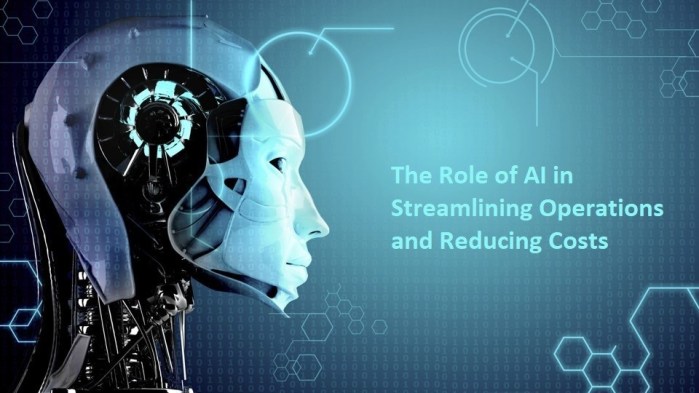The Role of AI in Streamlining Operations and Reducing Costs
AI vs. Traditional Automation
Traditional automation involves rule-based systems for repetitive tasks without human intervention, done through scripts or tools like data entry. While effective for simple tasks, it lacks adaptability and decision-making abilities beyond set scenarios. AI-driven automation, in contrast, uses AI to learn from data over time, handling complex tasks like pattern recognition and predictions. It can analyze large datasets, identify trends, and make real-time adjustments, abilities traditional automation lacks. The key differences lie in flexibility and intelligence, as AI-powered automation can handle unstructured data, evolve through machine learning, and provide insights, making it ideal for dynamic applications like predictive maintenance and demand forecasting.
Read also: The Impact of Automation and AI on Supply Chain Efficiency: Transforming Logistics for the Future
Integration of AI in Business Systems
AI integration across departments involves embedding AI tools in CRM systems for customer behavior insights and ERP systems for inventory management optimization. This enhances efficiency and collaboration. Continuous monitoring and training are essential for AI integration, with models needing regular retraining with fresh data to adapt to changes. Monitoring helps detect issues like data drift that can affect model accuracy. Overall, embedding AI, utilizing cloud-based solutions, and continuous monitoring are key for successful AI integration in businesses.
AI in Streamlining Operational Processes
1. Inventory Control
AI systems monitor stock levels in real-time, triggering reorder alerts when inventory is low. Machine learning predicts demand fluctuations to align inventory with needs, forecasting surges during holidays or events. AI-powered robotics and storage systems organize inventory, manage processes, and reduce errors to enhance warehouse efficiency and order fulfillment.
2. Customer Service and Support
AI chatbots and virtual assistants handle routine inquiries and process orders, reducing the need for human agents. They can also handle complex customer issues, improving response times and satisfaction. Sentiment analysis tools gauge customer feedback to identify areas for improvement. AI routes customer inquiries based on urgency and preferences, improving customer satisfaction.
3. Logistics Optimization
AI development services in logistics improve route optimization by analyzing traffic patterns, delivery windows, and fuel costs for efficient transportation, reducing travel time and operational expenses.
4. Financial Management and Auditing
AI automates financial reporting by collecting data and compiling real-time analysis, reducing manual work and improving accuracy.
AI in Enhancing Customer Experience and Services
1. Improving Customer Support with AI
AI chatbots powered by AI offer instantaneous customer support, addressing queries and resolving issues 24/7. They handle numerous inquiries at once, allowing human agents to tackle more intricate cases. Sentiment analysis tools assess customer mood and feedback, enabling businesses to respond promptly and improve service quality. AI systems automate issue categorization and resolution, prioritizing urgent matters for swift resolution and heightened customer satisfaction.
2. Enhanced Customer Data Analysis
AI-driven data integration gathers customer data from multiple sources to provide a complete view of behaviors. Advanced analytics tools powered by AI can identify patterns in customer behavior. AI also helps in mapping the customer journey and analyzing touchpoints that impact satisfaction. This enables businesses to enhance their strategies, product development, and customer engagement for an improved overall experience.
3. Real-Time Customer Engagement
AI enables proactive communication through personalized messages and notifications. It can send follow-ups when customers abandon their shopping carts or offer incentives to complete purchases. AI-powered live chat support allows instant engagement and escalates issues to human agents when needed. Social media monitoring tools monitor brand mentions, enabling real-time customer engagement addressing concerns and building brand loyalty. Overall, AI enhances customer satisfaction through timely and personalized interactions across different channels.
AI in Financial Management and Decision-Making
1. Enhanced Financial Analysis and Reporting
AI empowers real-time processing and analysis of extensive financial data, aiding in timely report generation. It automates financial report creation, saving time and ensuring accuracy. AI improves forecasting accuracy and data interpretation.
2. Fraud Detection and Prevention
AI builds profiles of consumer behavior to identify anomalous activity, such as significant withdrawals from unfamiliar locales. To secure sensitive financial data and reduce the chance of data breaches, enhanced security methods using AI include encryption, machine learning development, and biometric identification.
3. Risk Assessment and Management
Risk analysis using AI models To assist firms assess risk exposure and put mitigation plans into place, historical data is analyzed to find patterns of credit, market, and operational risks. Businesses may prepare for unfavorable events by using AI technologies to stress test financial models and simulate economic scenarios. By evaluating different data sources to create more precise credit scoring models, AI improves credit assessment, improves lending choices, and lowers default rates.
Challenges and Considerations in Implementing AI
1. Integration with Existing Systems
Many organizations use outdated legacy systems that may not be compatible with AI technologies, posing integration challenges. Interoperability is key for maximizing AI benefits, requiring planning and resource allocation for integration. Implementing AI involves changes in workflows, necessitating effective change management to ensure employee understanding and acceptance, minimizing resistance to change.
2. Skill Gaps and Training
Organizations must invest in training programs to prepare current personnel for successful AI use. Cross-department collaboration between IT, data science, and business operations can help bridge skill gaps and drive innovation in AI implementation.
3. Cost and ROI Considerations
Organizations must carefully assess AI deployment costs, which include technology, infrastructure, and talent charges. Balancing costs and advantages is critical to ensure that the investment in AI is consistent with the entire company plan.
Authors Bio
Ankit Patel is the CEO of Wappnet Systems, a leading software development company specializing in AI, Web3, blockchain, and mobile app development. His years of experience in the IT industry drive innovation and deliver cutting-edge solutions for businesses worldwide. He is dedicated to empowering businesses with advanced technological solutions, and his strategic vision continues to shape the future of digital transformation across industries. Follow him on Facebook, Twitter, and LinkedIn.





Leave a Reply